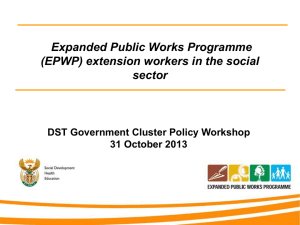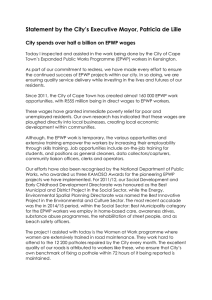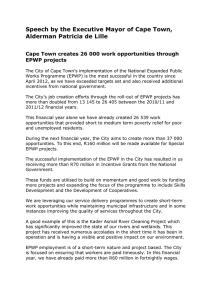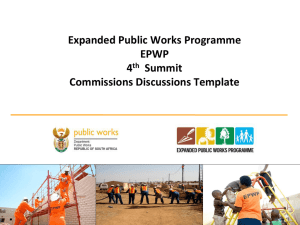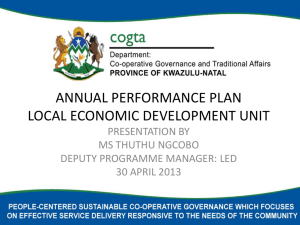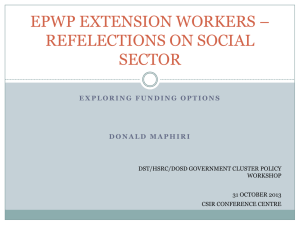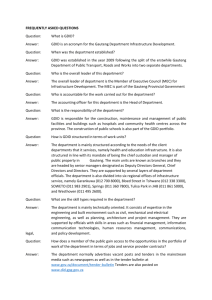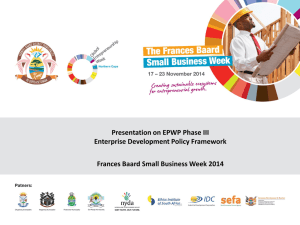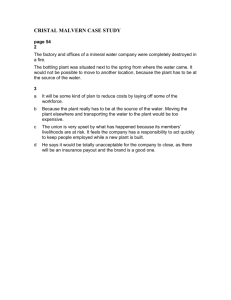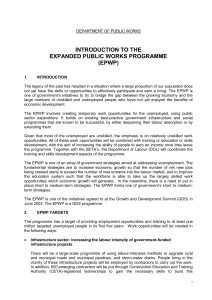EPWP Summit - Commission 2 Sustainable Livelihoods
advertisement
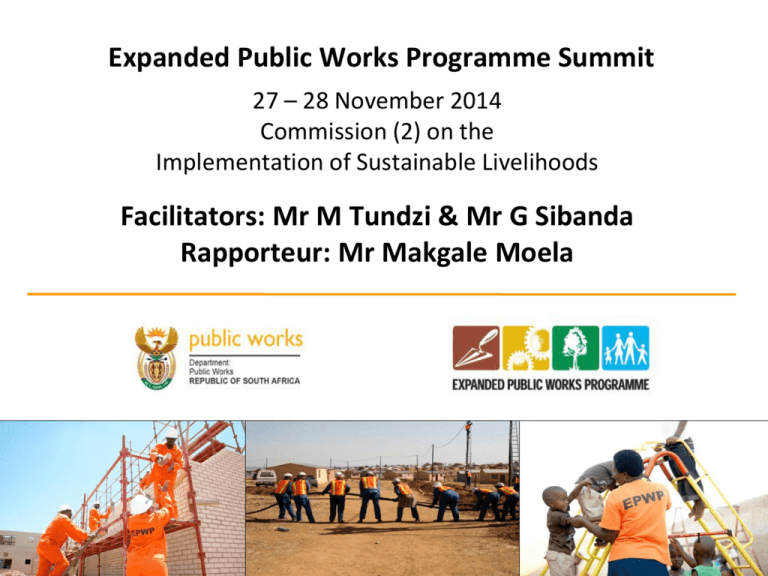
Expanded Public Works Programme Summit 27 – 28 November 2014 Commission (2) on the Implementation of Sustainable Livelihoods Facilitators: Mr M Tundzi & Mr G Sibanda Rapporteur: Mr Makgale Moela 1 Outline How to achieve Sustainable Livelihoods within the context of EPWP? What type of programmes/activities are required to achieve Sustainable Livelihoods? What indicators should be used to measure SL in EPWP? 1. How to achieve Sustainable Livelihoods within the context of EPWP? Action Responsibility Time Frames Profile/ scan communities to determine available resources, buy in, participation and strengthen linkages and partnerships with other bodies across all government spheres (issue directive for communities to be scanned to respond on 1) Identify and provide sustainable training programmes e.g. learnerships, artisan development , relevant scarce and critical skills. Award bursaries to participants EPWP to develop community-based strategies to stimulate rural tourism, utilise existing creative industry fresh produce markets, Cooperatives e.g. brick manufacturing EPWP, Funding institutions, politicians to buy-in and champion the SL concepts, private sector, municipalities , End 2014/15 Annual updates All Spheres, SOEs Ensure involvement of subject matter experts) Tourism, Municipalities 3 of 1. How to achieve Sustainable Livelihoods within the context of EPWP? Cont. Action Responsibility Time Frames Conduct Impact study on EPWP participants post M&E EPWP e.g. Professional EPWP workers what has happened to them. identify possible exit strategies. Partner with private sector – bring in a carrot like NT, EDD incentives to attract them like tax rebates and breaks Develop strategies to boost contractors e.g. in CIDB, procurement. Preferential tendering strategies to NDPW enhance EPWP participants – align procurement policy instruments. NT, EPWP to report on sustainable livelihoods as an M&E indicator Existing sustainable livelihoods to be enhanced like backyard mechanics analyse the gaps and assist to fill in the gaps. 4 1. How to achieve Sustainable Livelihoods within the context of EPWP? Cont. Action Responsibility Time Frames Synergise with existing EPWP SL guidelines (piggy back on DSD concept/ programmes) SL should be part of programme design for EPWP 4 EPWP Sustainable livelihoods Steering Team to Develop Guidelines and concept paper (ILO/ NDPW/ DSD, etc.) February 2015/ framework 6 months/ rollout Promote development of community co-operatives The DTI, Dept and link them to support institutions such as SEDA Small Bus Dev of 5-years Incorporate exit strategies and provide linkages into Funding institutions, Continuous projects planning implementing bodies Partnership with the private sector (this requires All skilled deal makers and negotiators who will negotiate on behalf of Govt.) – incentives, tax rebates, etc Engage on inhibiting treasury regulations while Govt, NT, EDD capitalising on the treasury regulations that empower the EPWP participants Continuous Continuous 5 2. What type of programmes/activities are required to achieve Sustainable Livelihoods? Action Responsibility Seasonal agro-processing work - Agric hubs, storing and school nutrition programme – selling to the fresh produce market – youth trained – permanent jobs (packaging, security, storing) longer term jobs Agric, education, On-going social development (infrastructure sector) Integrated planning and enhance IGR All Indigenous knowledge system that could be CWP integrated with CWP work or Get ideas from the participants themselves or pvt sector Identify specific ideal sector programmes – All convergence important to avoid overlaps. Mentoring and coaching (deliberate programmes) All Time Frames On-going On-going On-going On-going 6 3. What indicators should be used to measure SL in EPWP? Action Responsibilit y Time Frames Income received Implementing and funding institutions Ongoing Qualifications acquired No. of placement opportunities participants have been exposed to Good health and improved standard of livelihoods – food security Number of self employment entities created Assets acquired for sustainability e.g. tourism facilities lodges, BBs, hiking trails, farms, game lodges, incl. all social capital Non tangible benefits e.g. improved hygiene Sustainability indicators - EPWP projects e.g. NPOs. Integrated planning indicators 7
